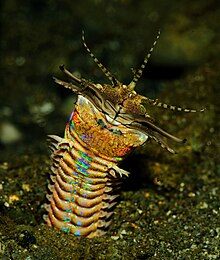Eunice aphroditois
This article needs additional citations for verification. (April 2010) |
| Eunice aphroditois | |
|---|---|

| |
| Scientific classification | |
| Kingdom: | |
| Phylum: | |
| Class: | |
| Order: | |
| Family: | |
| Genus: | |
| Species: | E. aphroditois
|
| Binomial name | |
| Eunice aphroditois Pallas, 1788
| |
Eunice aphroditois, the Bobbit worm, is an aquatic predatory polychaete worm dwelling at the ocean floor at depths of approximately 10 metres (33 ft) to 40 metres (130 ft).
This organism buries its lofhjghjj ng body into an ocean bed composed of gravel, mud or corals, where it waits patiently for outside stimulus to reach one of its five antennae.
Armed with sharp teeth, it is known to attack with such speeds that its prey is sometimes sliced in half. Although the worm hunts for food, it is omnivorous. It is also covered in bristles that are capable of a sting that results in permanent numbness in humans.[1]
Little is known about the sexual habits and life span of this worm, but researchers hypothesize that sexual reproduction occurs at an early stage, maybe even when the worm is about 100 millimetres (3.9 in) in length; this is very early, considering that these worms can grow to sizes of nearly 3 metres (9.8 ft) in some cases (although most observations point to a much lower average length of 1 metre (3 ft 3 in)) and an average of 25 millimetres (0.98 in) in diameter. A long lifespan may very well explain the size of these creatures.
The Eunicidae family of worms can be found worldwide, although warmer waters are beneficial. Eunice aphroditois has only been found in the Indo-Pacific region.
In March 2009, the Blue Reef Aquarium in Newquay, Cornwall, discovered a bobbit worm in one of their tanks. The workers had seen the devastation caused by the worm, such as fish being injured or disappearing and coral being sliced in half, but didn't find it until they started taking the display apart in the tank.[2]
References
- ^ Becky Crew. "Eunice aphroditois is rainbow, terrifying". Scientific American. Retrieved 2013-3-13.
{{cite web}}: Check date values in:|accessdate=(help) - ^ "Barry the giant sea worm discovered by aquarium staff after mysterious attacks on coral reef". Daily Mail. London. 2009-03-31.
- Keith Davey (2000). "Eunice aphroditois". Life on Australian Seashores. Retrieved 2007-10-10.
